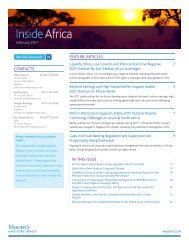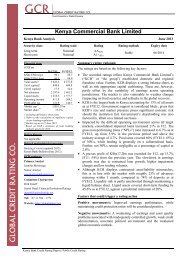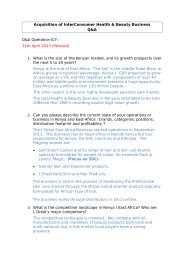NSE-Web-Prospectus-2014
NSE-Web-Prospectus-2014
NSE-Web-Prospectus-2014
Create successful ePaper yourself
Turn your PDF publications into a flip-book with our unique Google optimized e-Paper software.
Section 5<br />
Exchanges<br />
The following is selected information and statistics relating to<br />
securities exchanges and worldwide:<br />
5.1 World Exchanges<br />
There are over 95 securities exchanges around the world. Some<br />
large domestic equity market exchanges include NYSE Euronext<br />
(US), NASDAQ OMX (US), Japan Exchange Group - Tokyo, NYSE<br />
Euronext (Europe), Hong Kong Exchanges, Shanghai SE, TMX Group,<br />
Deutsche Borse, Australian SE and National Stock Exchange of<br />
India.<br />
5.1.1 Equity Markets<br />
On 31 December 2013, the global equity market domestic<br />
capitalization was in excess of USD 59 trillion and the number<br />
of listings crossed 43,000. The value of share trading in the<br />
month of December 2013 alone exceeded USD 4.2 trillion<br />
while the number of equity electronic book trades was 847<br />
million. In the same month there were 1.4 million securitized<br />
derivatives and over 6,000 electronic traded funds. The share<br />
turnover velocity varies across exchanges from as low as 0.1%<br />
to as high as 287%.<br />
5.1.2 Bond Markets<br />
On 31 December 2013, the number of bonds listed was over<br />
198,000 while the value of bonds traded was over USD 1.3<br />
trillion.<br />
Source: World Federation Exchanges website<br />
5.2 Africa<br />
In Africa, the large exchanges include Johannesburg Stock<br />
Exchange, Nigeria Stock Exchange, Egyptian Exchange, Casablanca<br />
Stock Exchange and Nairobi Securities Exchange.<br />
Kenya is well represented in the FTSE ASEA Pan African Index<br />
(excluding South Africa) which is designed as a regional index - that<br />
involves 14 countries, contains no more than 30 constituents per<br />
country and has a maximum country weight of 20% at review.<br />
The index is designed for the creation of index tracking funds,<br />
derivatives and a performance benchmark.<br />
Stocks are free float weighted to ensure that only the investable<br />
opportunity is included. Index constituents are categorized in<br />
accordance with the Industry Classification Benchmark, the global<br />
standard for industry sector analysis.<br />
5.3 Listed Exchanges<br />
The information below is selected to showcase listed exchanges:<br />
5.3.1 Reasons to go public<br />
Traditionally stock exchanges have been mutual structures<br />
with access to trading floors restricted to some intermediaries -<br />
members. Since the beginning of the 1990’s several stock<br />
exchanges have demutualized, i.e. they became for profit<br />
companies and opened ownership to outside investors. In<br />
addition, a growing number of exchanges have introduced their<br />
own shares on the stock markets they operate - a process<br />
called ‘self listing’ - emphasizing at the same time the for-profit<br />
and public nature of the activity. There has been a sharp rise in<br />
the number of for-profit exchanges, demutualisations and selflistings<br />
in the last fifteen years.<br />
Some reasons that lead demutualized exchanges to go public are:<br />
(1) a higher level of democracy in the relevant country;<br />
(2) to raise capital to invest in new technology and other<br />
infrastructure;<br />
(3) anticipated future higher level of competition from peers;<br />
(4) more capital market liberalization;<br />
(5) enhanced reputation and increased investor confidence and;<br />
(6) to facilitate mergers and acquisitions.<br />
5.3.2 Listed Exchanges<br />
The following are selected examples of listed exchanges: ASX<br />
(Australia); BM&F Bovespa (Brazil); Bolsa Mexicana de Valores<br />
SAB de CV (Mexico); Bolsas y Mercados Espanoles (Spain); Bursa<br />
Malaysia (Malaysia); CBOE Holdings (United States of America);<br />
Deutsche Boerse (Germany); Dubai Financial Market (United<br />
Arab Emirates); Hellenic Exchanges SA (Greece); Hong Kong<br />
Exchanges & Clearing (Hong Kong); Japan Exchange Group<br />
(Japan); JSE (South Africa); London Stock Exchange Group<br />
(United Kingdom); Multi Commodity Exchange of India (India);<br />
Philippine Stock Exchange (Philippines) and Warsaw Stock<br />
Exchange (Poland).<br />
Source: Mondo Visione website<br />
In June <strong>2014</strong>, the countries and the number of constituents to the<br />
Index were Botswana (7), Egypt (30), Ghana (12), Ivory Coast (15),<br />
Kenya (25), Mauritius (30), Morocco (28), Nigeria (30), Rwanda (1),<br />
Tunisia (20), Tanzania (5), Uganda (4), Zambia (7) and Zimbabwe<br />
(24). Total constituents was 238.<br />
Source: ASEA Yearbook 2012 and FTSE (a global leader in indexing<br />
and analytic solutions).<br />
28






